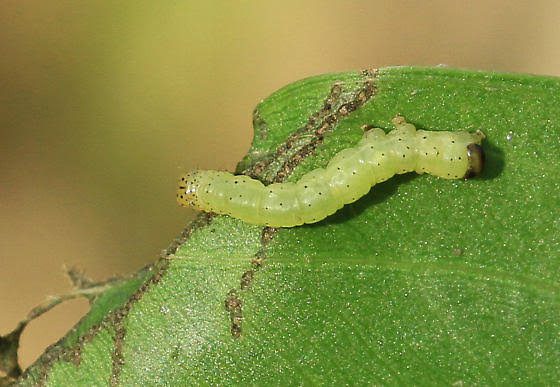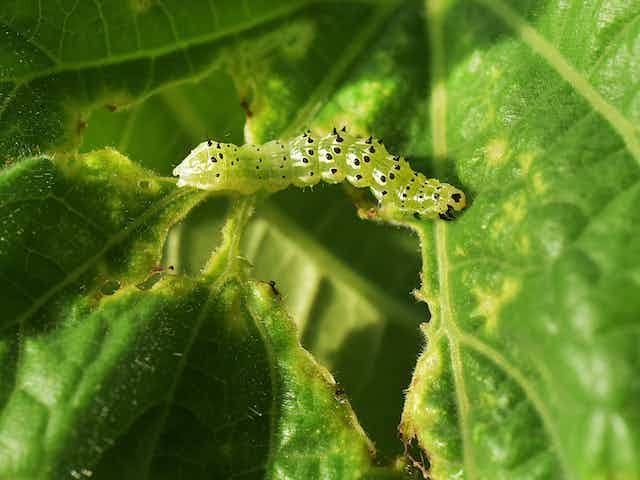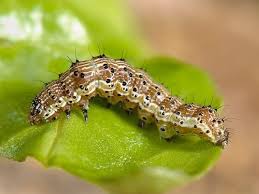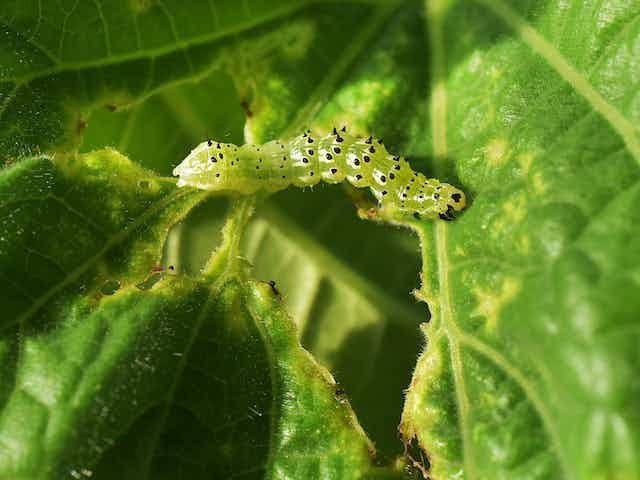Caterpillars, such as cabbage worms (Pieris rapae) and tomato hornworms (Manduca quinquemaculata), play a crucial role in the ecosystem. These little creatures are the larval stage of butterflies and moths. Let’s delve into their fascinating world.
Caterpillars begin their journey as tiny eggs laid by adult butterflies or moths. Once hatched, they grow rapidly, munching on various plants. Cabbage worms, for example, have a preference for cruciferous vegetables like cabbage and broccoli. Meanwhile, tomato hornworms have a penchant for feasting on tomato plants.
Despite their somewhat notorious reputation as garden pests, caterpillars contribute to the natural balance. They serve as a vital food source for many predators, including birds and insects. Additionally, their feeding habits can control plant populations and prevent overgrowth.
As caterpillars eat, they undergo a remarkable transformation. Their bodies go through a series of stages called instars, shedding their old skin each time to accommodate their expanding size. This process continues until they reach maturity and are ready to undergo metamorphosis.
The intricate dance of metamorphosis sees caterpillars transform into pupae, encased in a protective cocoon or chrysalis. Within this structure, their bodies undergo a complete makeover, rearranging tissues and forming the intricate structures of adult butterflies or moths.
Observing caterpillars can be an educational and awe-inspiring experience. Their vibrant colors and unique markings often serve as a form of defense, warning potential predators that they might taste unpleasant or be toxic. This adaptation is known as aposematism.
In addition to their ecological role, caterpillars have been studied for their potential medicinal properties. Some species produce substances that researchers are exploring for their antibacterial and antiviral properties. Understanding these aspects of caterpillars contributes to our broader understanding of the natural world.
So, next time you spot a cabbage worm munching on your vegetables or a tomato hornworm exploring your tomato plants, take a moment to appreciate the intricate journey of these fascinating creatures. From tiny eggs to voracious eaters and ultimately majestic butterflies or moths, caterpillars are an essential part of the circle of life.
Rrad Also: Ackees: History, Nutrition, Health Benefits and Growing Guide
Plants Affected by Caterpillars

Caterpillars can have a notable impact on various plants, affecting them in different ways. These voracious eaters are known for their diverse feeding habits, targeting a range of plant species.
One common example is the cabbage worm (Pieris rapae), which predominantly feasts on cruciferous vegetables such as cabbage, broccoli, and kale. These caterpillars can cause damage to the leaves, reducing the plant’s overall health and potentially impacting the yield of these crops.
Another notorious plant-invading caterpillar is the tomato hornworm (Manduca quinquemaculata). These caterpillars prefer to munch on tomato plants, consuming leaves and even green tomatoes. Their feeding activity can weaken the plant, affecting its ability to produce fruits and compromising overall crop quality.
Caterpillars are not limited to specific types of plants; their appetites extend to various crops and ornamental plants. Some caterpillar species may target fruit trees, ornamental flowers, or other garden plants. The damage they cause can range from cosmetic issues, such as chewed leaves, to more severe consequences, including reduced yields and stunted growth.
To mitigate the impact of caterpillars on plants, gardeners often employ strategies such as introducing natural predators, using organic pesticides, or implementing preventive measures like row covers. Understanding the specific caterpillar species affecting a particular plant is crucial for developing effective control methods while maintaining a balance in the ecosystem.
In agriculture, where crop health directly correlates with productivity, managing caterpillar infestations is crucial. Farmers often employ integrated pest management (IPM) strategies, combining biological, cultural, and chemical control methods. This approach aims to minimize environmental impact while effectively curbing caterpillar damage.
Biological control involves introducing or encouraging natural predators of caterpillars, such as certain parasitoid wasps and predatory beetles. These beneficial insects help maintain a balance in the ecosystem by preying on caterpillars and keeping their populations in check.
Cultural practices also play a role in caterpillar management. Crop rotation, for instance, disrupts the life cycle of specific caterpillar species by changing the location of host plants. Additionally, maintaining proper sanitation in and around fields can reduce caterpillar habitats and limit their reproduction.
While chemical control methods, including the use of pesticides, are available, there is a growing emphasis on environmentally friendly alternatives. Organic pesticides derived from natural sources are often favored to minimize the impact on beneficial insects and the overall ecosystem.
Educating farmers about the identification of caterpillar species and their life cycles is a key aspect of effective pest management. Early detection allows for timely intervention, preventing severe damage to crops.
Beyond the realm of agriculture, caterpillar infestations can impact urban and suburban landscapes. Gardeners and landscapers face similar challenges in maintaining the health and aesthetics of ornamental plants. The principles of integrated pest management are also applicable in these settings, emphasizing a holistic approach to caterpillar control.
Read Also: Longans: History, Nutrition, Health Benefits and Growing Guide
Damages Caused by Caterpillars

Caterpillars, with their insatiable appetites, can inflict various damages on plants, affecting their overall health and sometimes causing economic losses. The extent of damage depends on factors such as the caterpillar species, plant type, and environmental conditions.
1. Feeding Damage: The primary mode of damage caused by caterpillars is through feeding. Caterpillars use their powerful mandibles to chew on leaves, stems, and even fruits. This feeding activity can result in the loss of foliage, weakening the plant and reducing its ability to photosynthesize. Severe defoliation may lead to stunted growth, decreased yields in crops, and even death of young plants.
2. Crop Yield Reduction: In agricultural settings, caterpillars can have significant economic implications by reducing the yield of crops. For example, cabbage worms can target cruciferous vegetables, affecting the quality and quantity of harvested produce. This reduction in crop yield can impact farmers’ incomes and the availability of food resources.
3. Secondary Infections: Caterpillar feeding can create entry points for pathogens, making plants more susceptible to secondary infections. Open wounds from caterpillar bites provide opportunities for bacteria, fungi, or other harmful microorganisms to invade the plant, leading to diseases that further compromise plant health.
4. Damage to Fruits: Certain caterpillar species, like the tomato hornworm, have a particular affinity for fruits. Their feeding on fruits can result in cosmetic damage, making them unappealing for consumption. Additionally, damaged fruits may be more susceptible to rot or fungal infections, affecting the overall quality of the harvest.
5. Stress and Weakening: Continuous feeding by caterpillars induces stress on plants, diverting energy from growth and reproduction to defense mechanisms. Weakened plants may become more susceptible to environmental stresses, such as drought or extreme temperatures, further compromising their ability to thrive.
6. Aesthetic Impact: In ornamental gardens, caterpillar damage can affect the aesthetic appeal of plants. Unsightly chewed leaves and damaged flowers may diminish the visual quality of landscapes, requiring additional efforts for maintenance and restoration.
Mitigating caterpillar damage involves a combination of preventive measures, early detection, and targeted control strategies. By understanding the nature of the damage caused by caterpillars, gardeners, farmers, and researchers can develop effective approaches to minimize the impact on plants and crops.
Control and Preventive Measures

Controlling and preventing caterpillar infestations requires a comprehensive approach that combines various strategies. These measures aim to strike a balance between effectively managing caterpillar populations and minimizing the impact on beneficial insects and the environment.
1. Biological Control: Introduce natural predators and parasites that feed on caterpillars. Beneficial insects like parasitoid wasps, predatory beetles, and certain birds can help keep caterpillar populations in check without the use of chemical pesticides.
2. Crop Rotation: Implementing a crop rotation strategy disrupts the life cycle of specific caterpillar species by changing the location of host plants. This reduces the likelihood of continuous infestations and helps maintain a healthier plant environment.
3. Trap Crops: Planting specific crops that caterpillars prefer away from the main crop can act as a distraction, drawing caterpillars away from valuable plants. This method helps protect the main crop from extensive damage.
4. Physical Barriers: Use physical barriers like row covers to shield plants from caterpillar infestations. These covers prevent adult butterflies or moths from laying eggs on the plants, effectively interrupting the early stages of the caterpillar life cycle.
5. Handpicking: Regularly inspect plants and manually remove caterpillars by hand. This method is practical for smaller gardens or localized infestations and can be an effective way to control caterpillar populations without resorting to chemical interventions.
6. Beneficial Nematodes: Beneficial nematodes are microscopic organisms that can be applied to the soil to target caterpillar larvae. These nematodes parasitize the larvae, reducing their numbers and helping control caterpillar populations.
7. Neem Oil: Neem oil, derived from the neem tree, is a natural pesticide that can disrupt the feeding and development of caterpillars. It is considered environmentally friendly and can be applied as a foliar spray.
8. Bt (Bacillus thuringiensis): Bt is a bacterial insecticide that specifically targets caterpillars. It produces toxins harmful to certain larvae, making it an effective and selective control method. It is commonly used in organic farming.
9. Attract Beneficial Insects: Encourage the presence of natural enemies of caterpillars by planting flowers that attract beneficial insects. Ladybugs, lacewings, and predatory wasps are examples of insects that feed on caterpillars and their eggs.
10. Monitoring and Early Detection: Regularly monitor plants for signs of caterpillar infestations, such as chewed leaves or frass (caterpillar droppings). Early detection allows for timely intervention, preventing extensive damage.
By combining these control and preventive measures, individuals can effectively manage caterpillar populations while promoting a more sustainable and environmentally friendly approach to pest management.
Frequently Asked Questions (FAQs) About Caterpillars
1. Q: What is a caterpillar?
A: A caterpillar is the larval stage of butterflies and moths. It is a worm-like creature with multiple segments, often characterized by its voracious appetite for plant matter.
2. Q: What do caterpillars eat?
A: Caterpillars have diverse diets. Their food preferences depend on the species, but they commonly feed on leaves, stems, flowers, and fruits of various plants.
3. Q: Do all caterpillars turn into butterflies?
A: No, not all caterpillars become butterflies. Some caterpillars transform into moths. The specific type of adult insect depends on the species of caterpillar.
4. Q: Why are caterpillars important?
A: Caterpillars play a crucial role in ecosystems. They serve as a food source for many predators, contribute to nutrient cycling, and are important pollinators in some cases.
5. Q: Are all caterpillars harmful to plants?
A: While some caterpillars can be considered pests due to their feeding habits, not all are harmful. Some species have specific host plants and play a role in maintaining ecological balance.
6. Q: How long does it take for a caterpillar to become a butterfly or moth?
A: The time it takes for a caterpillar to undergo metamorphosis varies among species. It can range from a few weeks to several months, depending on environmental conditions and species characteristics.
7. Q: What is metamorphosis?
A: Metamorphosis is the process through which a caterpillar transforms into an adult butterfly or moth. It involves distinct stages, including pupation and the formation of adult structures.
8. Q: How can I identify caterpillar damage on my plants?
A: Signs of caterpillar damage include chewed leaves, holes in foliage, frass (caterpillar droppings), and, in some cases, visible caterpillars on the plants.
9. Q: Are there natural ways to control caterpillar infestations?
A: Yes, natural methods include introducing beneficial insects, using biological pesticides like Bt (Bacillus thuringiensis), planting trap crops, and encouraging natural predators in the garden.
10. Q: Can caterpillars be harmful to humans?
A: Generally, caterpillars are not harmful to humans, but some species may have irritating hairs or toxins. It’s advisable to avoid direct contact with unfamiliar caterpillars to prevent potential skin reactions.
11. Q: What is the purpose of the silk thread some caterpillars produce?
A: The silk thread produced by certain caterpillars serves various purposes, such as building protective shelters, aiding in pupation, and facilitating the movement of caterpillars on surfaces.
Read Also: Top 20 Proven Benefits of Ginger Plant

